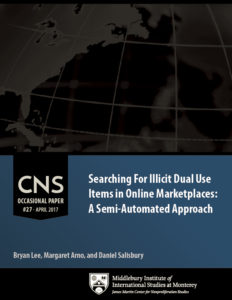April 24, 2017
Bryan Lee, Margaret Arno, Daniel Salisbury
Occasional Paper #27
Read the full Occasional Paper #27:
Searching for Illicit Dual Use Items in Online Marketplaces: A Semi-Automated Approach
Introduction
Purpose of Research

Online business today takes place in a global marketplace. Drop shipments and containerized shipping have made the export and import of materials and finished goods easier than ever. Anyone who has ever purchased something online is already familiar with this world from the consumer perspective. However, online marketplaces are increasingly important for business-to-business commerce as well. Suppliers of many high-tech products use online platforms for both domestic and international transfers, including products that are considered dual-use. Dual-use commodities are items which are used for civilian industry but also have potential application in the development of weapons of mass destruction. As the popularity of online marketplaces increases, so does the risk that illicit trafficking networks can misuse these platforms as a means of gaining access to critical dual-use commodities.
Well-known US-based platforms like eBay, Amazon, and Craigslist are thought to have reasonably effective procedures to screen for dual-use materials that might be controlled. However, even these firms have been challenged by the upsurge in use of their platforms for trade in potentially sensitive items. For non-US based platforms, reports highlighting how some sites have been used for illicit trafficking may have brought increased attention to the issue, but it remains unclear how effective screening methodologies are. Further, it is unclear if smaller sites that specialize in business-to-business transfers of industrial materials understand or implement controls on the sale of dual-use technologies.
This report explores the value of semi-automated approaches to gather and analyze data from online marketplaces to further understanding of the prevalence of dual-use technologies and the potential for proliferators to use these marketplaces to illicitly procure these items. It concludes that large-scale harvesting of online marketplace information is possible using off-the-shelf open source technologies and basic programming skills. Data gathered through such harvesting methods, however, are of generally poor quality. Machine learning techniques are likely to improve data collection and closer cooperation between online marketplaces and compliance officials would be an effective method of keeping these marketplaces safe and open for business.
